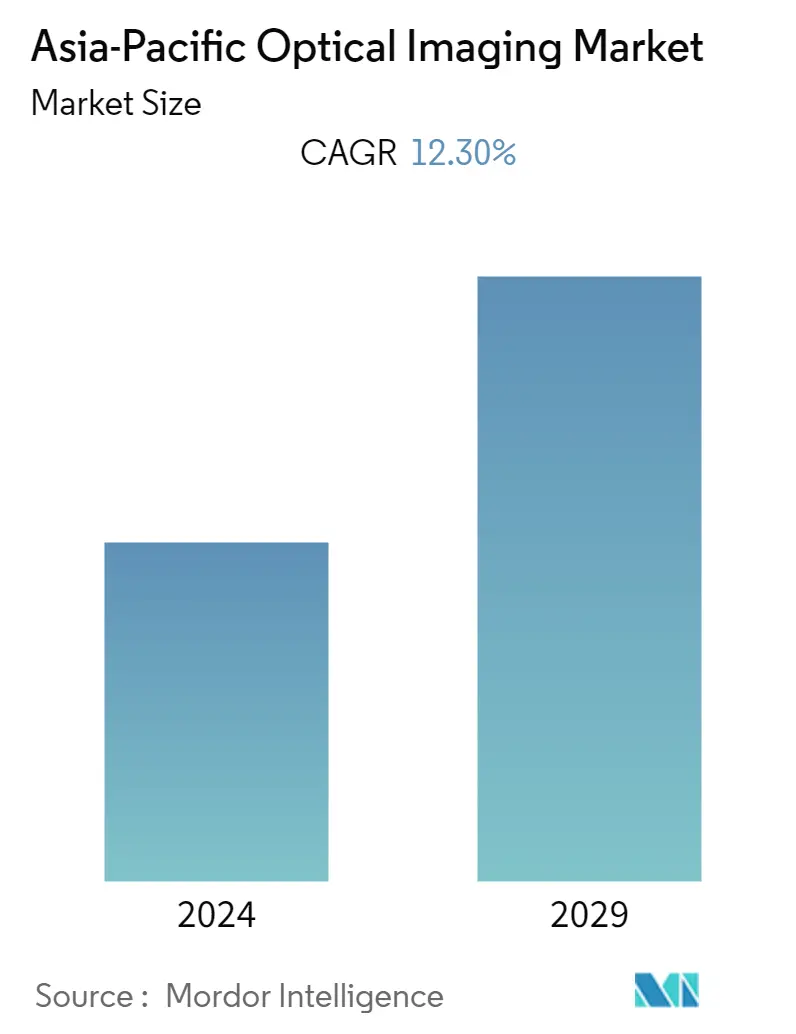Market Size of Asia-Pacific Optical Imaging Industry

| Study Period | 2019 - 2029 |
| Base Year For Estimation | 2023 |
| Forecast Data Period | 2024 - 2029 |
| Historical Data Period | 2019 - 2022 |
| CAGR | 12.30 % |
| Market Concentration | Medium |
Major Players
*Disclaimer: Major Players sorted in no particular order |
Need a report that reflects how COVID-19 has impacted this market and its growth?
APAC Optical Imaging Market Analysis
The Asia-Pacific optical imaging market is expected to register a CAGR of 12.3% during the forecast period (2022 - 2027). The market is expected to grow due to increased demand for non-invasive procedures and non-ionizing imaging modalities, particularly among the elderly.
According to the World Health Organization (WHO), while the proportion of people aged 60 or above in Southeast Asia was 9.8% in 2017, it will increase to 13.7% and 20.3% by 2030 and by 2050, respectively. Further, according to the United Nations, in 2040, the forecasted percentage of the population of Singapore above the age of 65 will be more than 29%. Ionizing radiation, such as X-rays, can cause various health problems, including deterioration of cell functioning and oncogenic mutations. Optical imaging techniques use non-ionizing radiation to reduce the harmful effects of radiation, resulting in increased utilization in hospitals and clinics, driving market expansion.
The increased use of optical imaging modalities for therapeutic and diagnostic purposes like disease diagnosis, preclinical research, and discrete molecular and cellular process imaging is likely to boost the market growth.
Diffuse optical tomography (DOT) and imaging (DOI) are witnessing robust growth in the region. They are non-invasive procedures that evaluate tissue parameters such as total hemoglobin concentration and blood oxygen saturation using light in the near-infrared region. The techniques are frequently utilized for breast cancer imaging, functional brain imaging, stroke detection, photodynamic therapy, and radiation therapy monitoring because they perform effectively in soft tissue.
The region is also featuring an increasing trend of collaborations and partnerships between companies to leverage their technical capabilities and manufacturing infrastructure to innovate advanced products and processes to cater to the evolving and complex needs of the aging consumer base. For instance, OmniVision Technologies Inc., a manufacturer of advanced digital imaging solutions, and Diaspective Vision GmbH, a high-quality hyperspectral and multispectral camera systems developer for medical applications, teamed up in November 2021 to develop the Malyna system, an advanced endoscopic camera based on proprietary multispectral imaging technology. Malyna provides indocyanine green (ICG)-based perfusion imaging and serves as a framework for the adaptation of additional algorithms for measured perfusion and tissue categorization without using a color agent. The device combines physiological data with a 4K live video stream to provide surgeons with objective decision-making support.
However, high instrument costs, strict regulatory approval procedures, a scarcity of qualified operators, and inadequate reimbursements for optical imaging operations limit the market's growth. Several imaging and diagnostic departments have seen a quick drop in optical imaging case volumes as a result of COVID-19, owing to the increasing requirement for social distancing among patients, physicians, and other healthcare professionals.
